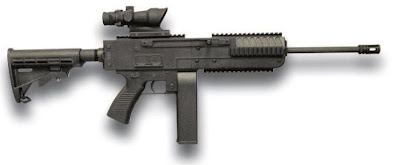
I'm not sure if this really counts as a rare weapon as it has yet to enter full production, but hey, right now there are not many of them, so they are rare.
The Lightweight Small Arms Technologies (LSAT) is a venture of AAI and Ares, Inc., ATK, St. Marks Powder, Battelle Science and Technology Group, and Omega Training Group with the goal of producing a weapon and ammunition that retains the power, range, and accuracy of current systems while dramatically reducing the weight of both the weapon and the ammunition.
The problem is this, in US service (for now) the Squad Automatic Rifleman carries the M249 SAW and a basic load of 600 rounds. This weighs about 38 pounds. Combined with armor and helmet, water, and whatever else gear is needed and suddenly, it is not going to be easy to jump a fence or run a couple of miles up a mountain. The LSAT seeks to reduce the weight of the SAW and ammo by 38% to 23 pounds. This would greatly reduce the strain on soldiers, and Marines, especially in hot environments or difficult terrain.

The ammunition type has yet to be decided and there are two main types. Caseless and Plastic cased telescoped. Most likely the weapon will be eventually paired up solely with the plastic telescoped cased ammunition because it is a less risky option, although it is heavier than the caseless ammo.


Plastic cased telescoped ammunition (CT)
Caseless telescoped ammunition (CL)
If all this talk of caseless and polymer cased ammunition is sounding familiar, well, that's because it is. The US Army experimented with a caseless weapon system, the HK G11, in the early 80's. It was eventually abandoned, mostly because the caseless ammunition had not reached an acceptable level of technological maturity. There were concerns about its resistance to the elements and its shelf life. Another reason given was lack of a demonstrable lethality increase from the systems in use at the time. The committee also had concerns about cook off (when a round is fired unintentionally due to excessive heat in the chamber) and they felt that the G11 did not have a sufficient way to get rid of possible misfired rounds as it was designed without a need to eject spent cases. Also ,I believe that the cost of the system was also noted as being too high.
Back to the present and polymer cased ammo is not entirely new either. The problem with it is that the chamber of a firearm, especially a light machinegun, is a very hot place and it has tended to melt or burn the polymer of the case, causing failures to feed, eject, or fire. The current thinking is the AAI and friends have found a way to produce a plastic capable of withstanding the high temperatures and pressure of the firing chamber. Smarty-pants-types have stated that the polymer case will actually cut down the risk of a cook off, because the polymer is a much better insulator than the traditional brass cartridge which transfers the heat quickly and well, which can cause the round to go off. Seems like it makes sense to me. Also, as anyone who has gotten ejected brass down their shirt can attest, that shit is HOT. And while that is bad when you can't untuck your shirt fast enough, it serves the function of taking some of that heat and energy out of the weapon. Without that, the interior of the weapon will need some other way to deal with the excess heat.
We will have to wait to see if AAI and their partners have made the next essential technology for small arms or if this is just another dead end. So while this weapon is rare for now, it is entirely likely that it may be issued by the thousands in a couple of years.

Hughes Lockless, HK G11...
ReplyDelete